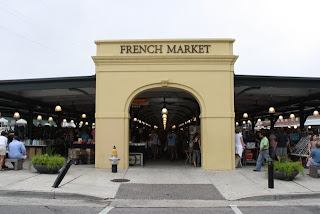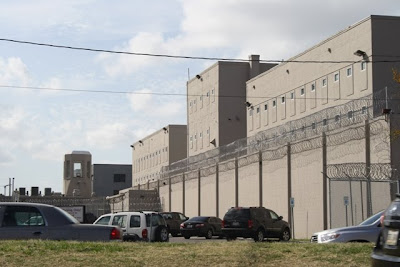More importantly, we are seeing some real stories start to break through. If you want a summary of those stories, go to some other blog. This one is for pictures.
The show opens up with a scene in the studios at WWOZ, where Coco Robicheaux decides to decapitate a chicken in order to shake some of that bad juju. He mentions the commercialization of the french market.
The market is located in the corner of the Vieux Carre, the French Quarter, close to the river levee. There has been a market here for centuries. Of course, in its earlier days it was a place where Indians traded with one another and colonists on the riverbank. Now, it's a flea market to buy chinese trinkets and shit that you can buy on Bourbon, Canal, or any other swap meet in any other city, really.
After the storm there was a renovation project that built some stalls for drink and food stands, but it's still pretty boring, unfortunately. I guess they sell vegetables and stuff now, so it's not quite as lame as it was before the storm. Here's a little history of the market.
We see Chef Deshautel in her house---downstairs is gutted, upstairs is still "livable." She burns some eggs and cries. Not so much because of burned eggs, of course. Frying a few more eggs is no problem. But it hit home to see an emotional response like that, which I'm guessing most people experienced a few times on their own. I know I had a few moments of doubt, whether to return to the city or move away to a place where nothing bad ever happens...of course, I came back and am glad I did.
This is the same fight LaDonna goes through with her husband---lots of people evactuated temporarily to Baton Rouge only to realize that life would go on just fine there, and without the problems of what used to be home: crime, blight, unresponsive government and a feeling that no matter how much you worked things would not change for the better. That's just New Orleans, though, and that feeling was there before the storm and regardless of it.
In the scene where Clarke Peters is explaining the intricacies of plaster walls versus sheetrock (a standard discussion about what to install when the whole thing's been flooded), the owner of the house is wearing a Finn McCool's t-shirt.
Finn's is on Banks, in Mid-City. It's an Irish pub with its own story of rebirth after the storm. The pub sponsors a local amateur soccer team, itself the subject of a book written by one of its managers, Stephen Rea. He's a great guy and the book can be found here.
Finn's is the place to find televised soccer, although football is the preferred nomenclature at this establishment. If you're in New Orleans in June, why not check out a few World Cup games with a pint from the bar? I don't recommend cheering for France, though. You might get your teeth kicked in.
The new characters introduced in this episode were a pair of street musicians. While I've never seen an asian girl who plays the violin, the Quarter does have its share of street performers.
The two Treme characters are more of the Marigny type, judging by their attitudes and the fact that they're having a drink at the Spotted Cat, on Frenchmen street.
Frenchmen Street is on the far end of the quarter, and is the off-the-beaten-path for locals and savvy tourists to check out some live music and good restaurants. Sukho Thai, Marigny Brasserie, and Adolfo's are all good spots in the triangle.
Snug Harbor is another venue mentioned in this episode as a non-Bourbon place to catch live music.
Just a note---each episode has sort of shown this but not really made an obvious comment about it, but nobody in New Orleans pronounces the city "New Orleens." I've also never heard anyone pronounce it "Nawlins," unless it was some kind of tourist thing. The british reporter in the premiere did it, and so did the tourist kids in the second episode.
I myself pronounce the city New OR-lee-uhns, but I hear everything from New Or-lense, to N'wah-lee-uhns.
Of course there are exceptions (as noted in the show), like when the city name appears in a song (Do you know what it means/To miss New Orleans). Likewise, the Parish where the city is located is Orleans Parish, pronounced "Or-leens." Anything related to the Parish is pronounced that way too, like Orleans Parish Prison (OPP).
The Marigny is separated from the French Quarter by Esplanade, which you should recall from before.
The tourists get sent up Esplanade by Davis in his short stint as desk jockey for a hotel. He sends them to Bullet's---"If the cab driver asks, yes, you're sure." Bullet's is actually on AP Tureaud, which is off of St. Bernard, which is off of Esplanade.
Yes I snapped this from my car. Part of me feels a little dumb taking pictures of people's places after they were portrayed in the show---I'd rather not make them feel weird and me like a gawker. I'm a little ambivalent about it, but I still think it's interesting. I've never been to Bullet's. I've never really been up in this area of town, actually. This little project is giving me a good opportunity to explore the city I've lived in almost a decade without actually seeing everything. I will say, though, that I do not feel threatened in any of these places.
Bernette's daughter complained about her school. I think we'll see a little more about the school situation in New Orleans after the storm, since it was a period of large upheaval, where the state government stepped in and took over management of the Orleans Parish school board.
That's a complicated conversation that, as someone who didn't go to school in New Orleans and who has no children in school in New Orleans, I might not be qualified to comment on. So here are some pictures of the schools discussed in the show. Many city schools are old, beautiful buildings.
Lusher took over the building after Katrina. I'm not sure what the status of that situation is, but I know that it incensed many black people in the city who felt that they had been ousted from one of their places in the dead of night without any say in the matter.
I don't think that this is the Lusher that Bernette fille is speaking about. There's another Lusher school just off of Broadway, which I think we'll see more of as the show goes on.
Most white kids in New Orleans pre-Katrina went to private catholic schools. Public schools were almost entirely filled with black kids. That's just the way it was. Not to say that black kids don't go to private schools, but when 7th grade costs $12,000 a year it's pretty tough to manage unless you're earning a good salary.
The high school system in New Orleans is such that when you meet someone for the first time and strike up a conversation, they are likely to ask you where you went to school. If you answer "Tulane," or "Harvard," you'll get a blank stare---the important information is what high school you went to.
Most white men that I meet went to one of a few all-boys schools. Brother Martin, Jesuit, and Newman are the three most common answers. Jesuit is on Carrollton and Banks, right up the street from Finn McCool's, actually.
As a product of public education all the way through undergrad, I never imagined that I would send my kids to private schools. Living in New Orleans has changed that, but I see promise in the charter school system that has evolved from the pre-storm mentality.
Speaking of schools right up the street from a bar...
This is St. Augustine, or St. Aug. It's a mostly-black private school on A. P. Tureaud, literally a block or two from Bullet's.
The St. Aug marching band is legendary. In their uniforms, they look like purple and gold Marvin the Martians. During Carnival they march in several parades, and every time you can hear them coming blocks away. A rustle moves through the crowd---"Is that St. Aug?" "Yeah, here they come." They kick ass.
Credit for this photograph goes to http://laurelstreetblog.com/.
Note the difference in architecture between the schools. Here is a charter school in the Touro area, between Magazine and Prytania on Milan. It's right in the middle of a residential area, like most things in New Orleans.
Here's another catholic school at the corner of Claiborne and State Street, Ursuline Academy.
There are several all-girls schools in the city as well. Here are two of the most famous: McGehee and Sacred Heart.
McGehee is in the Garden District.
Prytania is a residential thoroughfare that cuts through the city, parallel to the river and other main streets like Tchoupitoulas, Magazine, and St. Charles. Remember, in this part of town the city grid looks like a spiderweb.
There is, of course, a main complex for the school that is not located inside of an antebellum mansion.
Check out some of the school's neighbors on Prytania:
If my sources are correct, this last house used to be owned by Nic Cage.
Sacred Heart has two campuses on St. Charles. Like McGehee, the old campus is also very understated.
Looking forward to tonight's episode.













































